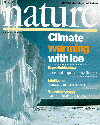
Floating ice shelves are vulnerable to climate change at both their upper and lower surfaces.
The extent to which the apparently air-temperature-related retreat of some northerly Antarctic
Peninsula ice shelves presages the demise of their much larger, more southerly, counterparts
is not known, but air-temperature effects are unlikely to be important in the near future.
Oceanographic measurements from beneath the most massive of these southerly ice shelves -
the Filchner-Ronne Ice Shelf - have confirmed that dense sea water resulting from sea-ice
formation north of the ice shelf flows into the sub-ice-shelf cavity. This relatively warm so-
called High Salinity Shelf Water (HSSW) is responsible for the net melting at the ice shelfs
base. Here the author presents temperature measurements, from the same sub-ice-shelf cavity,
which
show a strong seasonality in the inflow of HSSW. This seasonality results from intense
wintertime production of sea ice, and the author argues that the seasonal springtime warming
can be
used as an analogue for climate warming. For the present mode of oceanographic circulation,
the implication is that warmer winters (a climate warming, leading to lower rates of sea-ice
formation, would cause a reduction in the flux of HSSW beneath the ice shelf. The resultant
cooling in the sub-ice cavity would lead, in turn, to a reduction in the total melting at the ice
shelfs base. A moderate warming of the climate could thus lead to a basal thickening of the
Filchner--Ronne Ice Shelf, perhaps increasing its longevity.
K W Nicholls (email: k.w.nicholls@pcmail.nerc-bas.ac.uk)
Predicted reduction in basal melt rates of an Antarctic ice shelf in a warmer climate (Letter to Nature)
Nature 388, 460 (1997)